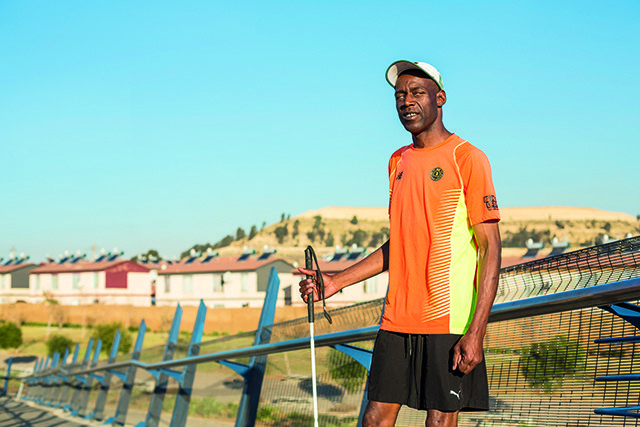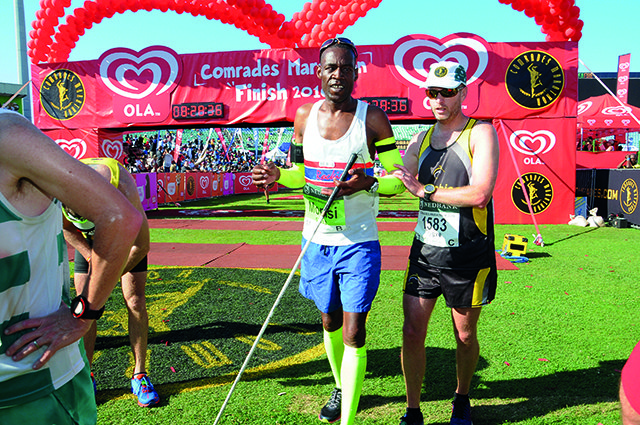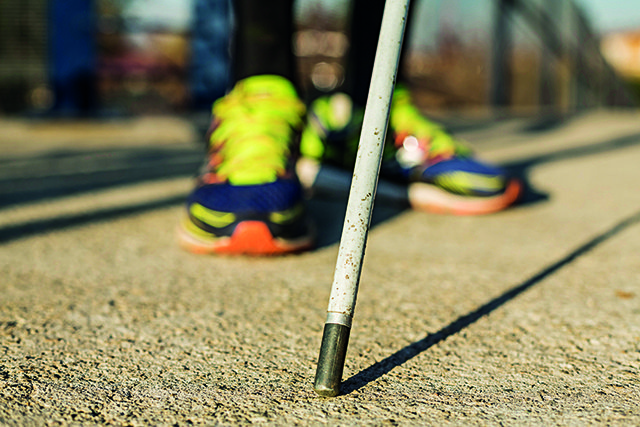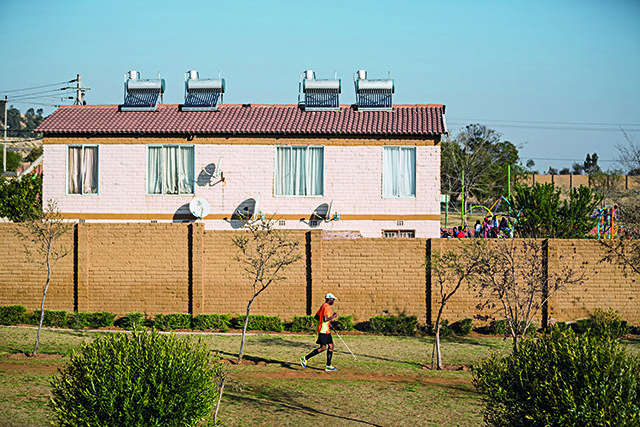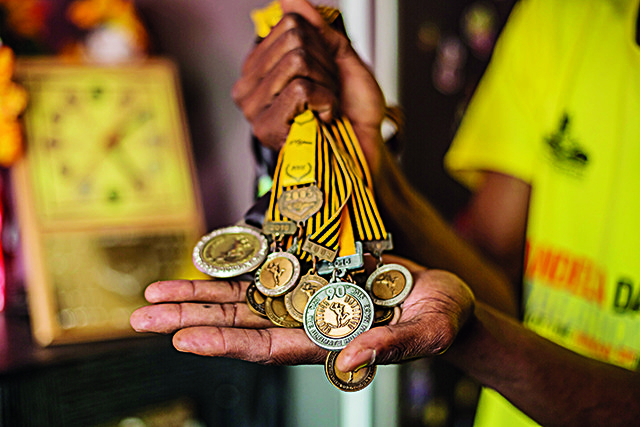Meet SA’s Fearless Blind Runner: Richard Monisi
What can a runner who can’t see teach us about the way we look at the world?
What can a runner who can’t see teach us about the way we look at the world? – By Lisa Nevitt
Richard Monisi fell four times during the Comrades Marathon this year. The first time, he tripped over a cat’s eye in the road. The second time, he stumbled into a pothole, and on a third occasion, he took a sharp corner and bumped into a pavement. His fourth accident happened just 500 metres from the finish line.
But for Monisi, it was just another day beating the odds. Why? Well, Monisi is legally and functionally blind, with just five per cent sight in his left eye.
As he shuffled into the stadium, he heard a cacophony of cheering and music. “Amazing!” the spectators shouted. “Awesome!” The noise only confused his senses further. Unsure of the way, he lost his balance and fell. But as swiftly as he hit the grass, he felt hands on either side of him lifting him to his feet – fellow runners were on hand, determined to help him. “Let’s go!” they encouraged, urging him not to give up.
Monisi finished the Comrades in 8:28. Even more significant than his time was the fact that he ran most of the race without the assistance of a guide.
But he’s no stranger to falling down, picking himself back up again, and carrying on: he’s been doing it his entire life.
Born blind
As a child, because he had never been able to see, Monisi didn’t even realise he had a disability. He often bumped into things, and fell, and hurt himself – but he thought that was normal; didn’t everyone fall? Each time, he got up and carried on playing.
Growing up in a rural village near Louis Trichardt was difficult. The basics were scarce, people were starving, and no-one was helping. Monisi lived with his mother Anna, his father James and his brother Lucky.
But though Monisi played happily with his older cousin Gloria, he was never given the same opportunities and responsibilities that she had. Gloria and Lucky were often sent on errands, to buy sugar or tea. They attended the local school. Monisi, on the other hand, stayed at home. At seven years old, he asked his mother: “Why?”
Anna explained. “You can’t be sent on errands, because you can’t see where you’re going. You’re blind, which means you’re disabled. Disabled children can’t cope in a general school, and we certainly can’t afford to send you to a specialist school.”
Monisi felt a great sense of injustice – and even then, at his young age, he refused to give in to his ‘inferior’ status.
“Then let Gloria come with me, and I’ll go and buy sugar,” he pleaded. “And if I fall, so what? I’m used to it! I want to be like the other children.”
“You are disabled,” Anna repeated.
Light in the dark
When Monisi was 12, he contracted typhoid – an infectious and dangerous bacterial fever – and was admitted to Elim Hospital in Louis Trichardt.
While he was there, the attending doctors took the opportunity to examine his eyes and confirmed what his mother had been telling him all along – he was blind. But there was hope, and they were able to operate on Monisi’s left eye.
Two days after his operation, a doctor removed the bandages, and light flooded into what had been a lifetime of darkness. Although Monisi couldn’t make out shapes or even colours, he moved a finger in front of his eye, fascinated by the way the light shifted. He had five per cent vision. Not much. But five per cent was more than before. The doctors warned him: “Don’t look at the sun – it will make you completely blind again.”
They began to teach Monisi how to use touch – feeling rounded edges, right angles and corners – to identify objects. The eyes, it seemed, were not the only way of ‘seeing’.
On his behalf, the doctors applied to the Pretoria School for the Blind. It was there that Monisi finally gained access to the facilities and equipment he needed to participate in sports – swimming first, then basketball.
But he had started his schooling late, and because of his age, when he reached grade 10 he was asked to leave. Sadly, he did not get the opportunity to write his matric exams.
Monisi received a ‘disability’ grant from the government, but it was very little. His father was working in Johannesburg at the time, which inspired him to pack a bag and catch a train to the big city.
For the first month, Monisi stayed with a friend, Manaba – a blind man he’d met at school in Pretoria. When the time came for Monisi to receive his next grant payment, he realised he didn’t have the money to return to Louis Trichardt and collect it. So for the next three months, he and Manaba sang and begged in the doorway of a mall. And people donated money, which the pair used to buy food.
But in the fourth month, a man called Gerald Fox – the founder of Rocky Road Runners – approached him in the mall. “You have a good physique – tall and slender,” he observed. “Even though you’re blind, you’d make a good runner.”
Fox made Monisi an intriguing proposition:
“If you stop begging and start running, I promise to support you.”
He offered the blind man a room at the back of his place. He would go on to train with him early in the mornings and after work, and then help him get a job at Services For The Blind. And once Monisi was established, Fox helped him to move into his own place – to live independently. (Sadly, Services For The Blind closed four years ago, leaving Monisi unemployed.)
How could Monisi disappoint the man who had done so much for him?
Monisi began to run
Monisi lived in Pennyville close to Westbury – far from Soweto and the suburbs, the most likely sources for a guide. So in training, he ran alone. Up and down, on a straight, one-kilometre section in his local park. He woke up at 3am and trained until 6am. It was the quietest time of the day, devoid of noisy traffic that could hamper his senses. To avoid bumping into things, he used a combination of hearing, touch and a cane. And so his passion for long-distance running was born – Monisi began to enter events.
He achieved a marathon personal best of 3:45, but wanted to do even better. He trained harder, and slotted a new PB: 3:15. Fellow runners warned those who were thinking of volunteering to guide him. “If you’re guiding this man, you must watch out,” they said. “He’ll burn you. You’ll hit the wall. He runs fast.”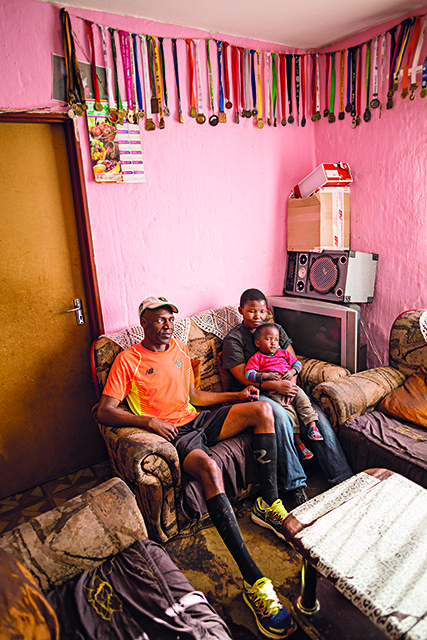
Monisi was 32 when he met Jane Mokone, who is also blind. She was the captain of the women’s team at a football tournament for the blind he attended at Filadelfia Secondary School in Shoshanguve. He liked Jane. She was patient, a good listener. Luckily, she gave him her phone number. In November 2003, the pair were married.
Then Monisi’s first son, Valentine, was born, in 2004; their second, Prince, is a year and 10 months old. Like his father, Prince can only see out of one eye.
For Monisi, the start of the Comrades Marathon is a horrible experience – it scares him. He can hear lots of people all talking at the same time, lots of people making nervous noise. The songs only add to his trepidation. As if the disorientation isn’t enough, he has only just met his pilot and guide, Florence Munyei, for the first time. Munyei stands next to him. She wears a belt, and attached to the belt is a piece of string for Monisi to hold.
The famous cock-crow sounds, signalling the start. “Even if I don’t finish, I’ll try my best,” Monisi reminds himself, as the crowd slowly surges forward.
For the first 10km, there are too many other runners for Monisi to set a pace. Munyei leads, advising him when there are obstacles in the way, and when to turn right or left. “Here comes the blind guy!” the pair shout when they want to pass other runners. Sometimes Monisi bumps into fellow competitors, and together they tumble.
But then, his guide has to admit defeat: Munyei can’t maintain Monisi’s brutal pace. Grasping his white stick, he decides to go it alone.
Monisi tracks the time by the sun: when it’s on his face, he knows it’s 8am; a bit higher, 9am. When he can see the shadow of the sun, it’s mid-afternoon.
“We’re halfway,” shouts a fellow runner, and Monisi recognises his voice from one of the races he did in training at home. His heart lightens – he remembers that the man behind the voice just happens to run at the same pace as him. Monisi knows he’s on track for a good time.
Sometimes he takes a wrong turn, but other runners – realising he’s blind – help out by calling him back to the route.
“I’m waiting for you, my man!” shouts a fellow competitor, running just ahead of him.
And when Monisi falls in the stadium, they pick him up, and their camaraderie carries him the rest of the way.
It’s through sheer determination, and his humble ability to connect with other people, that Monisi achieves the same as – more than – ‘able–bodied’ people are able to achieve.
Whatever hand life deals you, you don’t have to give in to it. You just need to find a different way of… looking at it.
Guidance For Your Guides
Are you thinking of being a guide for a blind runner? You’re probably nervous about the job, unsure of what to do – how hard do you pull on the tether, how much do you tell him or her? The American Foundation® For The Blind recommends the following, to make your job easier.
• Be explicit. Saying “Be careful here” doesn’t convey any information. The runner is already being careful. But “The ground is a little rough here” tells the runner what he or she needs to know.
• Put action first, followed by background information. “We’re approaching a crowd of people standing on the path, so…” doesn’t tell the runner what to do until it’s too late. Instead, say: “Move right – we’re approaching a crowd of people standing…”
• Ask about decisions in advance. If there are two routes, mention it as soon as you know, so you won’t have to stop to discuss the options. If you want to stop for water, say so before you get to the water station.
• When obstacles such as bumps or ruts can’t be avoided, alert the runner to them verbally. Be sure to mention the direction. “Kerb up” or “Kerb down” tells the runner whether to step high or expect a drop.
• Give advance warning of turns. Be sure to mention the direction.
• Especially in unfamiliar territory, tell your runner about the terrain. “We’re coming to a long, low uphill” or “We’ll be bearing to the right in a few steps” are good descriptions.
• Tell your runner about things the two of you are passing that might be of interest. Are there drinking fountains? Rugby fields? Shady areas? Vineyards? Public toilets?
Adapted from the website of the American Foundation® For The Blind (afb.org)
Images by Dominic Barnardt
READ MORE ON: comrades comrades-marathon inspiring people motivation



